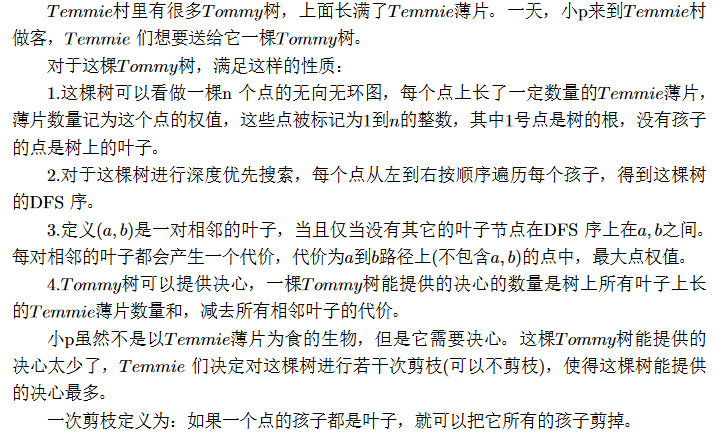

Title Solution
Consider which points can become adjacent son nodes,
That is, a certain point and its right chain, the next son of the father of the point and its left chain. The points in the point can be two adjacent leaf nodes.
So we started dp,
Set FIF fi to indicate that the last leaf node is the maximum value at i,
Consider how to transfer,
Obviously, find out two chains first. This process is similar to the process of lca.
Then maintain a prefix,
Discuss which chain the maximum value of the newly formed chain is on.
code
#include <iostream>
#include <algorithm>
#include <cstring>
#include<cstdio>
#include <string.h>
#include <cmath>
#include <math.h>
#define ll long long
#define N 1000003
#define P putchar
#define G getchar
using namespace std;
char ch;
void read(int &n)
{
n=0;
ch=G();
while((ch<'0' || ch>'9') && ch!='-')ch=G();
ll w=1;
if(ch=='-')w=-1,ch=G();
while('0'<=ch && ch<='9')n=(n<<3)+(n<<1)+ch-'0',ch=G();
n*=w;
}
int max(int a,int b){return a>b?a:b;}
int min(int a,int b){return a<b?a:b;}
ll abs(ll x){return x<0?-x:x;}
ll sqr(ll x){return x*x;}
void write(ll x){if(x>9) write(x/10);P(x%10+'0');}
int lst[N],nxt[N],to[N],tot;
int son[N],v[N],f[N],g[N],fa[N],id,n,m;
int now,dfn[N],dep[N],ans,q[N],x,y,mx[N];
int d1[N],d2[N],t1,t2;
void ins(int x,int y)
{
fa[y]=x;
nxt[++tot]=lst[x];
to[tot]=y;
lst[x]=tot;
}
void dfs(int x)
{
dfn[++now]=x;dep[x]=dep[fa[x]]+1;
for(int i=lst[x];i;i=nxt[i])
dfs(to[i]),son[x]=1;
if(!son[x])q[++q[0]]=x;
}
int main()
{
freopen("temmie.in","r",stdin);
freopen("temmie.out","w",stdout);
read(n);
for(int i=1;i<=n;i++)
{
read(v[i]);read(m);
for(int j=1;j<=m;j++)read(x),ins(i,x);
}
memset(son,0,sizeof(son));
dfs(1);
for(x=q[1];x;x=fa[x])f[x]=v[x];
for(int i=2;i<=q[0];i++)
{
t1=t2=0;
for(x=q[i-1],y=q[i];dep[x]>dep[y];x=fa[x])d1[++t1]=x;
for(;dep[x]<dep[y];y=fa[y])d2[++t2]=y;
for(;x!=y;x=fa[x],y=fa[y])d1[++t1]=x,d2[++t2]=y;
g[0]=mx[t1+1]=-2147473647;
for(int i=t1;i;i--)mx[i]=max(mx[i+1],v[fa[d1[i]]]);
for(int i=1;i<=t1;i++)g[i]=max(g[i-1],f[d1[i]]-mx[i]);
id=t1;x=y=-1000000000;
for(int i=t2;i;i--)
{
x=max(x,v[fa[d2[i]]]);
for(;id && x>mx[id];id--)y=max(y,f[d1[id]]);
f[d2[i]]=max(y-x,g[id])+v[d2[i]];
}
}
for(x=dfn[n];x;x=fa[x])ans=max(ans,f[x]);
printf("%d",ans);
return 0;
}